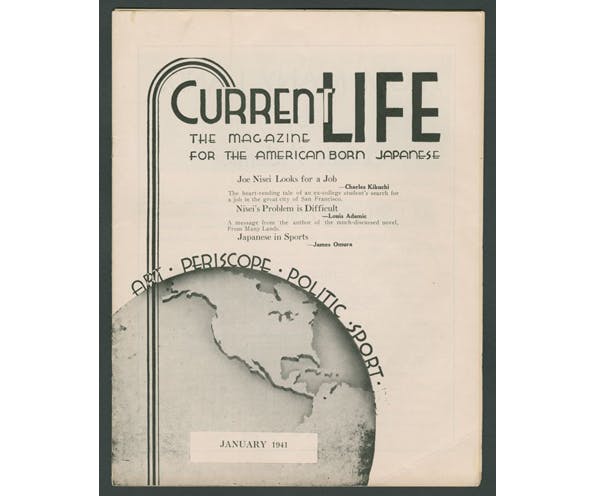
As the new PBS documentary series the Asian Americans debuts this week, The Department of Special Collections is pleased to make available recently digitized issues of Current Life, a literary and public affairs magazine created in 1940 by Nisei journalist James "Jimmie" Matsumoto Omura (1912–1994), whose papers are held in the Department of Special Collections. All issues of the magazine are present online, save the initial issue, which the Library will digitize from a bound copy (The Stanford Libraries were one of the initial subscribers to the publication; the digitized copies here were Omura's personal copies).
As Professor Art Hansen has noted in his biography of Omura for the Densho Encyclopedia, "In 1940 Omura started his own literary/public affairs magazine, Current Life. His new Nisei wife Caryl (neé Fumiko Okuma) gave Omura a comradely mate and his magazine a business manager/publicity director. Running for 15 issues, this monthly's centerpiece was Omura's editorials. They often chastised the JACL, particularly for not preparing Nisei for a probable clash between the U.S. and Japan and for partying at gala bashes instead of fostering constructive social action."
Omura himself recalled the impetus for the founding of Current Life in his memoir, Nisei Naysayer, posthumously published in 2018 by Stanford University Press:
“The first edition of Current Life rolled off the press in October 1940. In its initial year Current Life attracted the attention of prestigious universities, public libraries, secondary educators, and national associations across the land. Among its distinctions was a subscription from the Library of Congress, perhaps the first mainland Asian publication to be so recognized. It could also boast of an international readership with subscribers in Canada, Hawaii, and Japan. Current Life was fortunate to earn favorable write-ups in vernacular news-papers and to receive helpful publicity in metropolitan presses such as the Chronicle and Call-Bulletin of San Francisco and the Herald-Express of Los Angeles. Although it acquired paid subscriptions of a mere five hundred in the first year of its existence, its circulation, thanks in large part to the publication’s policy of providing potential subscribers with three complimentary issues, rose to approximately thirteen hundred per edition.
In the fifteen years of being on my own, I was unable to distinguish even a ripple of any material change in the depressed lot of the second generation in America. Nisei were still shut out from the main marketplace. Engineering graduates from such esteemed colleges as Yale, Harvard, Princeton, and Stanford were hawking fruits in Los Angeles public markets or, as some chronicler termed it, serving as “carrot washers.” In such an environment, it was no wonder graduates of American universities were going overseas to pursue their careers in the land of their parents. The job prospects of the Nisei were at a standstill, which was made more difficult by the haughty no-labor attitudes of the Japanese American Citizens League.
The reasoning that propelled the establishment of Current Life was that if the upper echelon of educators and administrators could be tapped, they in turn could extract a significant measure of tolerance and interest among their students, the future captains of American industries, to transcend the economic barriers of racism. It was in a sense a trickle-down theory, to work from the top down. In the past the Nisei were trying to climb the economic ladder in the most difficult ways, through the competitive ranks of the common workers. Resistance toward other laboring groups was formidable. Current Life was dedicated to unlocking this gridlock and to bridging the racial abyss. Much less bigotry existed in the field of literature than in the workplace. The publication sought to showcase Nisei talents but it also endeavored to demonstrate that it was not entirely a one-way street.” (pp. 111-112)
The February 1942 issue of Current Life proved the final issue of the magazine; Omura left San Francisco for Denver where he wrote influential editorials for the Rocky Shimpo criticizing both the U.S. incarceration of Japanese Americans and the collaborative role the Japanese American Citizens League. As Hansen has written in his biography of Omura for the Densho Encyclopedia:
"Debatably the most forthright Nikkei resister against the U.S. government's unconstitutional World War II policy of mass involuntary exclusion and incarceration of West Coast Americans of Japanese ancestry...Omura was indisputably the major Nikkei voice raised against the collaborative role of the Japanese American Citizens League (JACL) in this development. Possibly the earliest Nikkei to pursue governmental redress and reparations, Omura was the lone Nikkei journalist to editorialize against the JACL-endorsed 1944 federal decision to draft imprisoned Nisei into the military without first restoring their lost citizenship rights. Omura worked postwar as a landscape contractor. Upon retirement, he promoted redress and extended his earlier indictment of the JACL's wartime actions"
Special thanks to Stanford Library colleagues Astrid Smith, Rare Book and Special Collections Digitization Specialist in the Libraries' Digital Production Group, who oversaw the scanning of the issues, and Laura Wilsey, Metadata and Cataloging Librarian in Special Collections, who oversaw the metadata aspects of the project. And to the Omura Family and Professor Art Hansen for the generous donation of the original materials.